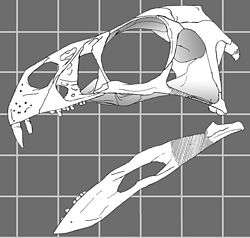Incisivosaurus
| Incisivosaurus Temporal range: Early Cretaceous, 123.2 Ma | |
|---|---|
 | |
| Restoration of the skull | |
| Scientific classification | |
| Kingdom: | Animalia |
| Phylum: | Chordata |
| Class: | Reptilia |
| Superorder: | Dinosauria |
| Order: | Saurischia |
| Suborder: | Theropoda |
| Infraorder: | Oviraptorosauria |
| Genus: | Incisivosaurus Xu, Wang & Chang, 2002 |
| Species | |
| |
Incisivosaurus ("incisor lizard") is a genus of small, probably herbivorous theropod dinosaur from the early Cretaceous Period of what is now the People's Republic of China. The first specimen to be described (by Xu et al. in 2002), IVPP V13326, is a skull that was collected from the lowermost levels (the fluvial Lujiatun beds) of the Yixian Formation (dating to the Barremian stage about 125 million years ago) in the Sihetun area, near Beipiao City, in western Liaoning Province. The most significant, and highly unusual, characteristic of this dinosaur is its apparent adaptation to an herbivorous or omnivorous lifestyle. It was named for its prominent, rodent-like front teeth, which show wear patterns commonly found in plant-eating dinosaurs. The specific name gauthieri honors Dr. Jacques Gauthier, a pioneer of the phylogenetic method of classification.[1]
Description
.png)
The initial description of Incisivosaurus by Xu et al. showed that the skull, which measures approximately 10 cm in length (4 inches), preserves the most complete dentition known for any oviraptorosaurian. Their cladistic analysis indicated that Incisivosaurus lies at the base of the oviraptorosaurian group, making it more primitive than Caudipteryx and the oviraptorids. A subsequent study by Osmolska et al. in 2004 described the distinguishing skeletal features of Incisivosaurus, including a long snout that made up about half the total length of the skull, a slender lower jaw with a long fenestra (opening), and its distinctive, large, flattened front teeth. In addition to these unique features, Incisivosaurus shared many traits with more typical oviraptorosaurs, allowing its classification with that group. Several features, including its numerous teeth (most advanced oviraptorids were toothless), show that it was a primitive member of the group, and several features of the skull even support a relationship with the therizinosaurs, another theropod group that was probably herbivorous.[2]
In 2009 the holotype skull was scanned and analyzed in three dimensions. The results indicated that Incisivosaurus had less bird - like air spaces in the skull bones than later oviraptorosaurs did. It also found that Incisivosaurus had reduced olfactory lobes and expanded optic lobes similar to ornithomimosaurs. It suggested that the most birdlike features of oviraptorosaurs may have been convergent with birds.[3]
Incisivosaurus is assumed to have been feathered like most other maniraptoran theropods. Its total body length has been estimated at just under 1 meter (3 ft.). It is possible that Incisivosaurus is the same species as Protarchaeopteryx, though more fossil specimens are needed before the two can be directly compared.
Classification
Incisivosaurus, as well as its potential synonym Protarchaeopteryx, were included in the phylogenetic analysis of a 2014 study on the group Paraves and its relatives. In the unweight cladogram, Incisivosaurus was rendered as the sister taxon to Protarchaeopteryx, with their group being the most primitive oviraptorosaurians. In both weighted analyses however, Protarchaeopteryx was found to be the most primitive oviraptorosaurian, with Incisivosaurus as the next most basal. One of the weighted cladograms, using TNT, is shown below.[4]
| Oviraptorosauria |
| ||||||||||||||||||||||||||||||||||||||||||||||||||||||||||||
| |
In popular culture
Incisivosaurus was featured in the third episode of the ITV series Prehistoric Park, which theorized that Incisivosaurus used its "wing" feathers for displaying and that it or a similar form was ancestral to gliding and flying forms.
See also
References
- ↑ Xu, X., Cheng, Y.-N. Wang, X.-L., and Chang, C.-H. (2002). "An unusual oviraptorosaurian dinosaur from China." Nature, 419: 291-293.
- ↑ Osmolska, H., Currie, P. J., and Barsbold, R. (2004). "Oviraptorosaura." in The Dinosauria (2nd edition), Weishampel, D. B., Dodson, P., and Osmólska, H., (eds). University of California Press.
- ↑ Balanoff, Amy M., Xu, Xing, Kobayashi, Yoshimura, Matsufune, Yusuke, Norell, Mark. "Cranial Osteology of the Theropod Dinosaur Incisivosaurus gauthieri (Theropoda: Oviraptorosauria)". AMERICAN MUSEUM NOVITATES, Number 3651, NEW YORK, NY 10024 35 pp., 17 figures June 25, 2009
- ↑ Godefroit, Pascal; Cau, Andrea; Hu, Dong-Yu; Escuillié, François; Wu, Wenhao; Dyke, Gareth (2013). "A Jurassic avialan dinosaur from China resolves the early phylogenetic history of birds". Nature 498 (7454): 359–362. Bibcode:2013Natur.498..359G. doi:10.1038/nature12168. PMID 23719374.
External links
- Incisivosaurus at DinoData
- sinopix.com (photo of skull, with skull of juvenile Liaoceratops below)
- Incisivosaurus gauthieri at DigiMorph